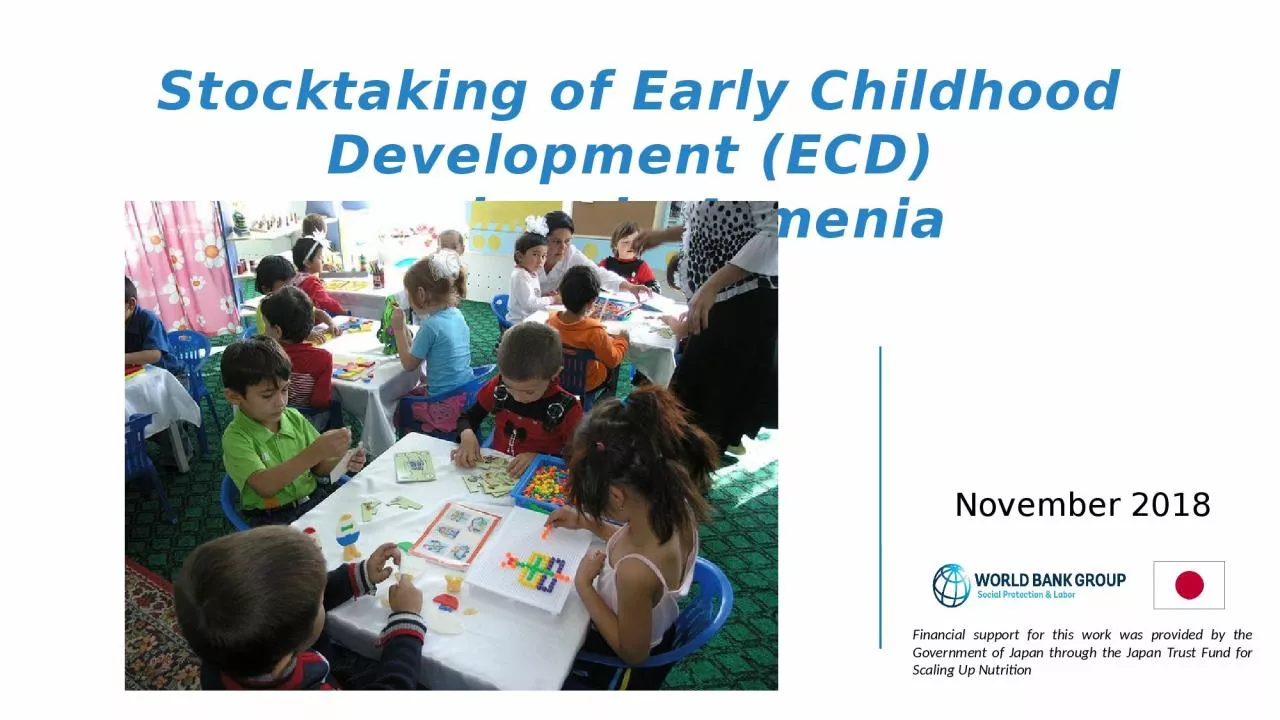

services in Armenia Financial support for this work was provided by the Government of Japan through the Japan Trust Fund for Scaling Up Nutrition The DATABASE WAS COLLECTED to POTENTIALLY inform referrals to ECD SERVICES from social workers during home visits ID: 1045818
Download Presentation The PPT/PDF document "November 2018 Stocktaking of Early Child..." is the property of its rightful owner. Permission is granted to download and print the materials on this web site for personal, non-commercial use only, and to display it on your personal computer provided you do not modify the materials and that you retain all copyright notices contained in the materials. By downloading content from our website, you accept the terms of this agreement.
1. November 2018Stocktaking of Early Childhood Development (ECD) services in ArmeniaFinancial support for this work was provided by the Government of Japan through the Japan Trust Fund for Scaling Up Nutrition
2. The DATABASE WAS COLLECTED to POTENTIALLY inform referrals to ECD SERVICES from social workers during home visitsSocial workers are critical players to promote behavioral change through home visits They have direct contact with most of the households at risk of malnutrition It is expected this services’ database will be hosted in by the MLSA and will be regularly updated by the government in the future2
3. 4 marzes were selected for the stocktaking: Yerevan, Lori, Ararat and GegharkunikPrioritization index based onDimension 1: Nutrition status of children under 5 years (stunting, overweight and anemia) Dimension 2: Percentage of multidimensionally poor Dimension 3: Availability of services (kindergartens that operate whole year, share of FBP beneficiaries, # of social workers)Represent urban and rural areas3
4. THE DATABASE COVERS THE UNIVERSE OF NON-PRIVATE SERVICES FOR FAMILIES WITH CHILDREN UNDER 5Services that meet all these criteria:For children <5 or pregnant womenChildren members of a family Universal or targeted to vulnerable populationProvided by public, NGOs and/or International Donor organizations (doesn’t include private)Services on health, nutrition, early stimulation/education and protection from stress 4Data collection included review of secondary information & direct interviews with key informants and services providers
5. The information covers 20 variables to characterize services*51. Name of service11. Public sector that regulates the service (health, education, social policy, etc.)2. Entity responsible for implementation12. Type of service (medical care, food provision, pre-school, care of children, etc.)3. Source(s) of information to complete this database13. Modality in which the service is provided (regular/ non regular, at home, in a center, etc.)4. Date information was gathered14. Main goal of service (support good health, promote good parenting, provide child care services, promote healthy nutrition, etc.)5. Location where service is provided15. Area were service is provided (specific districts, marzes, rural, urban, nationwide, etc.)6. Universal or targeted16. Is the service at full capacity7. Targeted population among early years (children 0 to 5 and/or pregnant women)17. Number of beneficiaries by age and socio-economic group8. Requisites to access the service18. Profile of staff providing the service9. Payments associated to service19. Total budget for this service, last year (In ֏)10. Frequency a typical beneficiary use this service20. Entity that funds the service (national/ local government, donor, NGO, etc.)*Questionnaire included suggestions from partner specialists at Save the Children, UNICEF and colleagues from different sectors at the World Bank
6. 797 ecd services were identified and characterized6
7. Most commonly services integrate interventions that tackle different aspects of early childhood development… though many of them overlap7Education services include pre-school + food provision, care of children, book/ toy libraries, provision of ed. materials, child protection from violence (344 services nationwide)Medical care include regular med. services + breastfeeding support, provision of ed. materials, child protection from violence (195 services nationwide) and group training and mentoring (30)Parental and child protectioninclude services such as food recipes, demonstrations, breastfeeding support, community (peer to peer) learning, group training and mentoring, provision of ed. material, child protection from violence (12 of 58 parental ed. and child protection services nationwide)Services tend to be universal (for all Armenian citizens), only 18% (141) can clearly identify a majority of their beneficiaries as poor or a vulnerable minority
8. The total number of beneficiaries covered by the database is 234,449*. there are requisites and, in a few cases, fees to pay to access to services8*Not all services have information on number of beneficiariesNumber of beneficiaries per marzeRequisitesFeesMain requisites are child’s birth certificate (721), child’s health passport (601) and statement of interest from family (407) Health free, however some facilities co-payment for services not included in basic packageEducation school-based & community-based preschools are free, however in some kindergartens there is a fee (in marzes amount depends on village council’s decision and residency in Yerevan)
9. 9Lessons learned & Next StepsStocktaking took 5 months of work of 1 National Coordinator and 4 data collectors (1 per area) –April to August 2018. Political changes occurred during this period Face to face meetings proved the most effective way to collect detailed information on services. Sometimes it was necessary to interview more than one key informant in the serviceServices seem to have difficulties reporting: Number of beneficiaries by age, refugee and poverty status Full time or part time staff, and staff that received training to provide ECD interventionsAnnual budgetsNext steps: Analytical exercise of match between demand and supply using this information to characterize supply and household surveys for characterization of households with children < 5 and/or pregnant women (demand)Potential use and update by MLSA to inform referrals of social workers during home visits on services promoting early childhood development
10. Thank you!10